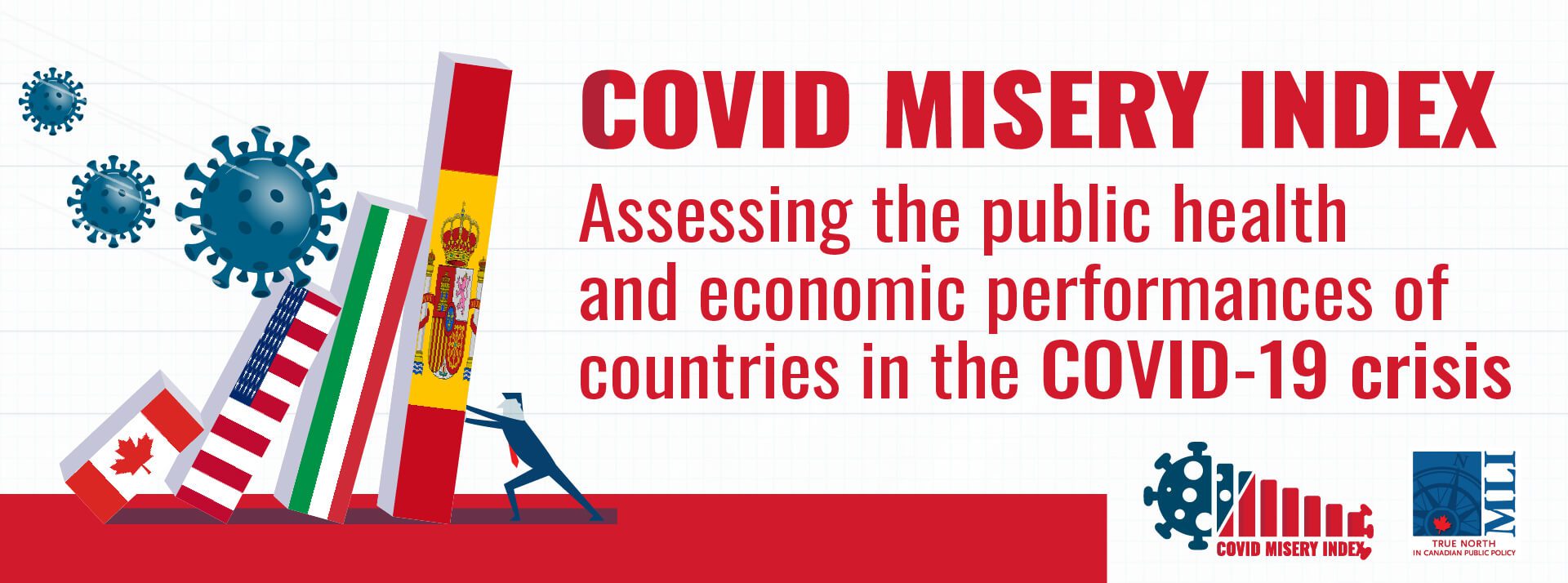 View the full, updated COVID Misery Index here. Download the data for the March 31 update here. For more information, including a full methodology and analysis of the initial COVID Misery Index, click here, and view the original, non-updated Misery Index here.
View the full, updated COVID Misery Index here. Download the data for the March 31 update here. For more information, including a full methodology and analysis of the initial COVID Misery Index, click here, and view the original, non-updated Misery Index here.
To find all the MLI products related to the COVID Misery Index, click here.
This week’s results
MLI COVID Misery Index Weekly Update (March 31, 2021): The Macdonald-Laurier Institute’s COVID Misery Index is updated each week as we follow the progress of 15 developed countries in fighting to preserve the health and prosperity of their citizens during the pandemic. Canada remains stuck in 11th place with a poor performance in responding to the pandemic, and severe economic fallout impacting Canadians. (For more detail about the methodology and initial results, click here.)
This week, in terms of Response Misery, the big story is the rollout of the vaccine in the US and the UK, which are both doing a great job in getting their most vulnerable, and increasingly the general population, vaccinated.
Canada’s response remains poor. There has been some improvement in the rates of any vaccination as some provinces have opted to increase the time gap between first and second jabs to allow more people to get the initial benefits of a first dose. However, Canada has fallen even further behind average on second shots.
Canada’s stringency measures remain more restrictive than many other countries, despite relatively low rates of COVID-19
At the same time, Canada’s stringency measures remain more restrictive than many other countries, despite relatively low rates of COVID-19. This speaks to the long-term challenges plaguing Canada’s response. Whereas more effective countries have succeeded in testing and contact tracing, Canada remains dependent on heavy-handed lockdowns to keep cases low and hospitals below capacity. Canada remains in last place in the Response Misery rankings, with a D Grade.
This week, Australia earned high grades on its response with incredibly high testing rates. Their aggressive testing regime has been a hallmark of their response as it has allowed them to limit any outbreaks and to continue to pursue an elimination strategy.
With regard to Disease Misery this week, while some countries have experienced significant declines in the cases and deaths caused by COVID-19, notably the US and the UK – most likely driven by their world-leading vaccination programs – there has been a marked increase in many of the European countries we include in our comparison.
The US and UK have had weeks with no days with reproduction rates greater than one. While excess deaths for the population aged 15+ remains stubbornly high for the US and the UK, we should note that this statistic is generally released a few weeks behind the others, and we expect that the rates of excess deaths will decline as these nations roll out their vaccines and safely reduce public health restrictions.
For the population aged 85+ the excess death rate was extremely high in Canada and out of proportion with the death rates from COVID-19 itself. This data suggests that in the fight against the coronavirus, those with other health conditions are suffering. Canada actually fell a bit this week in this category with a ‘B’ grade, driven by high excess death rates in both the 15+ and, particularly, the 85+ age cohorts.
Four-week rolling averages
In addition to the weekly results reported above, we also track four-week rolling averages to smooth out results. Over the past four weeks, the US continues to have high levels of COVID-19 and overall disease misery, although it is declining. Though the weekly average has Canada slipping a grade point, Canada’s four-week average Disease Misery receives a B+ grade due to quite low rates of disease, hospitalization and death from the virus, but high rates of excess mortality for those aged 15+ and especially those aged 85+. We must acknowledge that saving lives from COVID-19 has resulted in increased mortality from a wide range of other health conditions that otherwise could have been prevented.
Canada’s response to COVID-19 remains the worst ranking among our comparator countries. We have some optimism that if the increase in vaccinations we have seen over the past week continues, the Response Misery will decline. We are hopeful that as vaccines roll out, public health restrictions can be relaxed, although we do remain well behind the US and the UK in this regard. In addition to the US and the UK, we would also like to highlight the strong response from Switzerland in recent weeks. That country has been moving quickly with its vaccine roll-out and has relatively relaxed public health restrictions.
In the last four weeks, Disease Misery remains the highest in France and Italy. These nations may be in the midst of a third wave and, with new variants being more transmissible, are going back into more stringent lockdowns. Overall disease misery has been lowest over the past four weeks for Japan and Norway.
Looking ahead
There are a few areas where we are paying particularly close attention: vaccinations and excess deaths. Vaccinations are the clear and obvious path back to normalcy. The longer it takes to get there, the more public health restrictions may act as a barrier to accessing necessary health care and the longer Canada’s excess death rate will remain elevated despite its relatively low rates of COVID-19 infections.
Richard Audas, Faculty of Medicine, Memorial University of Newfoundland




